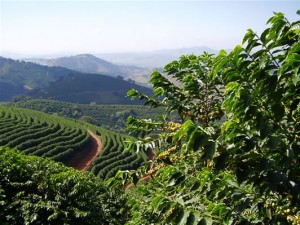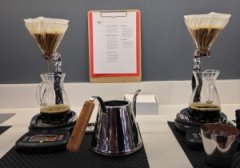Source of Coffee Industry chain-Coffee Garden
Coffee planting is probably the source of the whole coffee industry chain. if you want to save costs, coffee giants with profits will contract local coffee estates where they are going to do their best. In recent years, Starbucks, the fastest growing coffee leader in China, has also signed a supply agreement with Aini Coffee in Yunnan, China, and then the Brista Coffee training School will take you into the source of the coffee industry chain. A preliminary understanding of the establishment of the coffee garden.
1. Land selection, planning and reclamation
The quality of environmental conditions is closely related to the growth and development of coffee, which should be determined according to the growth habits and environmental requirements of coffee. Try to avoid choosing lowlands where cold air is easy to accumulate and condense frost; coffee roots are good, so choose well-drained and loose soil; coffee needs a calm wind environment, so in areas where there is no primary forest, consideration should be given to planning windbreaks. The planning of the size of the coffee garden is mainly based on the severity of local wind damage, which is generally 10 to 15 mu.
When reclaiming, pay attention to maintain the calm wind environment of the original woodland, the big trees that need to be left behind should be marked in shade and preserved, and the rest of the trees should be cut down before cleaning up.
Soil and water conservation of garden land is a very important work. Contour reclamation can be used on gentle slopes below 10 degrees, and contour terraces can be built on slopes above 10 degrees.
Hole digging can be combined with the construction of terraces, and the hole planting usually adopts the specification of 60 (length) × 60 (width) × 50 (depth) cm. When digging holes, the topsoil and subsoil should be placed separately so that the topsoil can return to the cave. The planting hole should apply sufficient base fertilizer before planting, generally apply rotten cow pen fertilizer, pig pen manure or compost, apply 30 kilograms to 50 jin per hole, mix with calcium superphosphate half jin, and then return to the topsoil after applying base fertilizer, and mix well. In the case of close planting, the average amount of water can be dug, and the planting hole should be dug 2-3 months before planting and fully weathered.
2. Planting density mainly depends on variety, pruning system, soil type and local rainfall, as well as management level, such as fertilization, irrigation, shading and so on.
Medium-grain coffee, using multi-dry shaping, the row spacing is generally 2.5 × 3 meters, and the single dry shaping is generally 2 × 2.5 meters.
Small seed coffee, using multi-dry shaping, the row spacing is generally 2 × 3 meters or 2.5 × 3 meters, and the single dry shaping is generally 1.5 × 2 meters or 2 × 2 meters.
Large seed coffee, the plant is tall, the row spacing is generally 4 × 5 meters.
Generally speaking, the soil is fertile, the annual rainfall is high, and the species with high management level can be sparse.
In recent years, if coffee is intercropped with coconut, betel nut, rubber or other crops, the row spacing can be determined according to the requirements of intercropping.
(3) the planting period and methods are generally planted at the beginning of the rainy season every year, and the best planting period for Hainan Island is from August to September, where there is rain, it can also be planted in February. 10-11-month-old strong seedlings with 2-3 pairs of branches should be selected for planting. It is best to dig seedlings in the afternoon on cloudy or sunny days, either with soil or roots. If the bare roots are planted, the seedlings should be fully hydrated the day before digging. After the seedlings are dug up, the leaves should be cut off.
Seedlings are best planted as they are dug. If they are to be transported far away or cannot be planted immediately, apply mud roots and put them in a cool place. Those who raise seedlings in plastic bags should cut through the plastic bags and put the seedlings into the planting hole. Do not make the soil in the bags loose, so as not to hurt the roots. The planting depth is the same as the original depth of the seedlings, and the lateral roots should be naturally stretched, pressed back to the soil, drenched and stamped immediately after planting. In order to cultivate multi-stem tree shape, oblique planting method or truncated stem method can also be used in planting.
3. Shade
The shady destination is to create an environment suitable for the growth and development of coffee to ensure high and stable yield through comprehensive agro-technical measures after planting. The shade degree should vary according to different cultivation environments and varieties. Coffee is grown in tropical high-altitude areas and in valleys and basins with high mountains on or around the east and west, with little or no shade; in the western slopes with low humidity, strong winds, long dry seasons and strong light, the shade should be appropriately larger. The shade degree of medium seed species is generally 30%, the shade degree of small seed species is 2530%, and the mature trees of large grain species are generally not shaded.
As a shaded tree species, it should have the conditions of fast growth, evergreen, sparse branches and leaves, deep main roots, few lateral roots, strong wind resistance and so on. According to the current production experience, Taiwan Acacia is a better shade tree, its disadvantage is that it has root disease, El Salvador Leucaena grows fast, but the crown is small.
The planting density of shade trees should be determined according to the size of their crowns. If the Taiwan Acacia tree is selected as the shade tree, one Taiwan Acacia tree can be planted every 2-3 rows and 4-5 trees between the coffee trees.
Shade trees are best planted in advance, and coffee trees are not planted until they can have a shade effect. If you fail to do so, you should plant temporary shade crops between the rows of coffee trees, such as pigeonpeas, edamame beans, Leucaena leucocephala, Tianyu, and so on, and cut them down when the permanent shade trees work.
Temporary shade trees should be thinned year by year according to different growth stages of coffee, permanent shade trees should cut off branches less than 2 meters so as not to affect the normal growth of coffee trees, and less shade should be retained at the fruiting period of about 2530%. The excess shade trees should be cut down, leaving about 10 million trees per mu.

Important Notice :
前街咖啡 FrontStreet Coffee has moved to new addredd:
FrontStreet Coffee Address: 315,Donghua East Road,GuangZhou
Tel:020 38364473
- Prev

Classification of taste characteristics of fine coffee in coffee encyclopedia
The taste characteristics of fine coffee, the so-called characteristics, refers to the differences in taste and flavor caused by the growth environment and variety differences of all kinds of coffee beans after proper roasting. The sour coffee beans, especially the high-quality new beans, have the best baking degree, while the bitter ones have a lighter baking degree, and then the sweet details are mostly selected beans produced in the highland.
- Next

The influence of Coffee temperature change on Coffee making
In the process of learning to make coffee, we should not only learn the method of making coffee, but also master the temperature of coffee production and the grinding technology of coffee powder. Because the internal substances of coffee are more complex, if you make coffee a little carelessly, it will make the coffee very bad, so we should learn how to make a cup of coffee that tastes better and is more popular. When doing coffee tasting
Related
- Beginners will see the "Coffee pull flower" guide!
- What is the difference between ice blog purified milk and ordinary milk coffee?
- Why is the Philippines the largest producer of crops in Liberia?
- For coffee extraction, should the fine powder be retained?
- How does extracted espresso fill pressed powder? How much strength does it take to press the powder?
- How to make jasmine cold extract coffee? Is the jasmine + latte good?
- Will this little toy really make the coffee taste better? How does Lily Drip affect coffee extraction?
- Will the action of slapping the filter cup also affect coffee extraction?
- What's the difference between powder-to-water ratio and powder-to-liquid ratio?
- What is the Ethiopian local species? What does it have to do with Heirloom native species?

